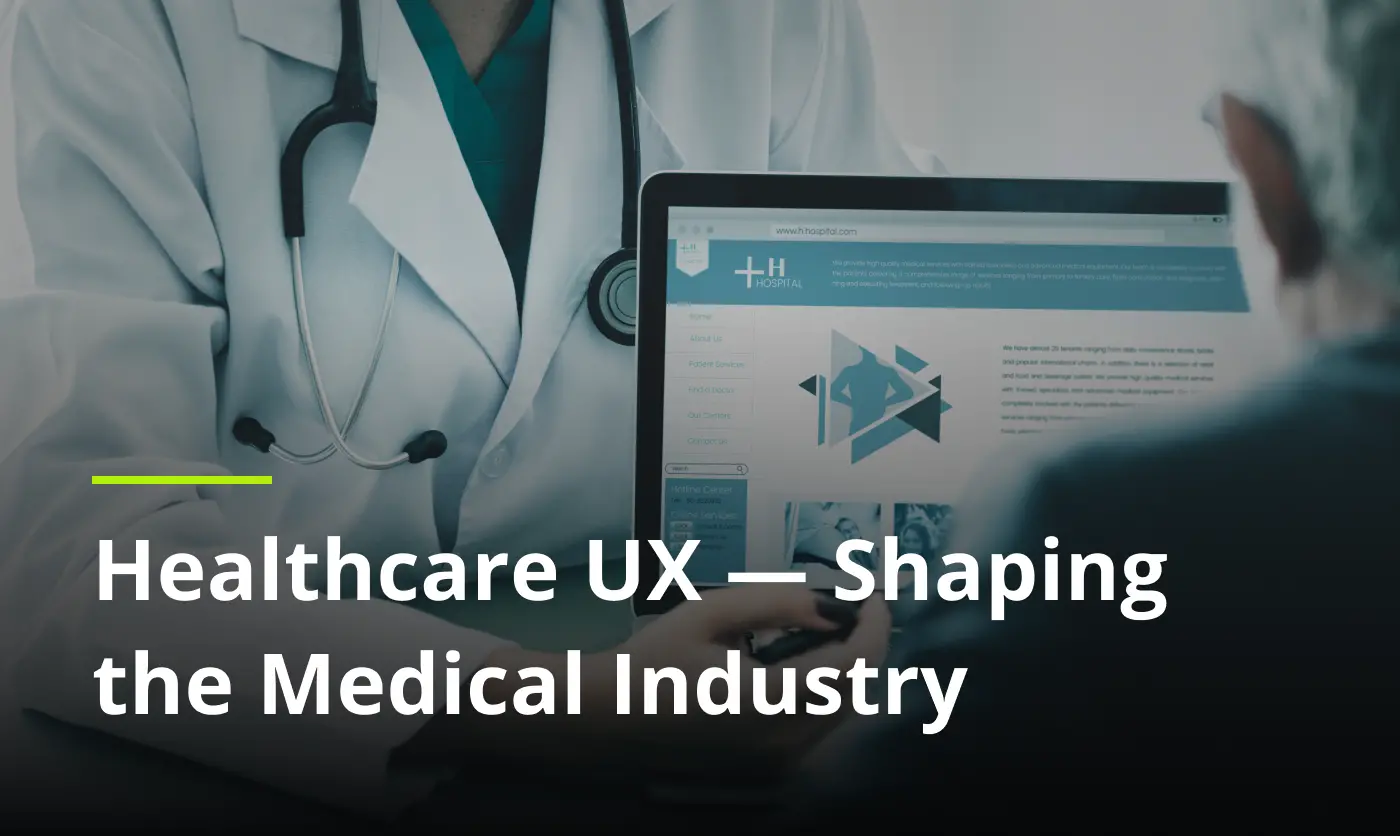Healthcare UX: Step-by-Step Guide

Impactful user experience design can improve people’s lives.
User-friendly and clutter-free design can help people quickly find the information they need, reduce time spent on excessive browsing, and facilitate digital adoption by people of different backgrounds and ages.
The impact is even more significant when talking about the healthcare industry. It’s a fast-growing market that is projected to reach $665.37 billion by 2028 globally, according to Verified Market Research.
At Limeup, we often work with healthtech startups and established medical companies worldwide to create healthcare UX solutions. Our healthcare UX designers know that stakes are exceptionally high when creating digital solutions for medical companies because we help save people’s lives through our design works. It’s a challenging but essential part of our everyday work.
In this article, our chief design officer Daria shares how we created custom healthcare UX design solutions for companies in the USA and Germany and lists the peculiarities of designing for the healthcare industry.
Before heading into the medical UX design, we’d like to explain the role of user experience design in healthcare and summarize the current state of UX in healthcare.
What is healthcare UX?
Healthcare user experience refers to designing digital healthcare products for users and with users in mind.
The end goal of UX design is to ensure the navigation is flawless, the digital product is understandable, and it helps users solve their challenges.
Digital healthcare products created with user experience design can be electronic health records, patient platforms, appointment scheduling systems, mental health mobile apps, and more.
It’s important to mention when we say “UX design for healthcare,” we not only refer to creating complex digital solutions for hospitals and established healthcare organizations worldwide. Some examples of well-designed UX for healthcare solutions are Apple Health, the app intended to organize users’ important health information on their iOS devices, Flo, female health and wellbeing mobile app, and Calm, a mobile app for improving mental health and sleep, to name a few.
Since the global health and wellness market observes significant growth and is predicted to expand at a compound annual growth rate of 10.9%, the importance of healthcare UX UI for creating impactful digital products is paramount.
In the following paragraphs, we’ve summarized the importance of good UX design for healthcare, what impactful UX design in healthcare means, and how UX design companies create digital solutions that improve people’s lives worldwide.
The impact of UX design on healthcare
When we say “impactful UX design for healthcare,” we mean user interface design that helps users solve their challenges and businesses achieve their goals.
For example, electronic blood pressure monitors should help people measure and track their arm blood pressure. Depending on the blood pressure rates, doctors can recommend taking blood pressure medications. Regular blood pressure control can save lives, while the failure to do so may have adverse consequences.
It’s vital for people of different ages to understand the design and screen elements and interpret them correctly. The too cluttered design might result in confusion and misunderstanding. On the other hand, a lack of important information on the display may result in inaccurate data interpretation.
Therefore, an impactful UX design in healthcare plays a crucial role in helping people understand their health conditions and improve their lives.

Source: Unsplash.
At Limeup, we offer various healthcare digital solutions to medical startups and established companies worldwide.
As a part of this article, we’d like to share some exclusive insights into how we designed and developed impactful UI UX healthcare solutions for our partners in the USA and Germany.
Our UX team has worked with an American medical startup, Raccoon Recovery, to design and develop a custom software solution to help patients with injuries recover faster.
A new healthcare platform was designed to help patients interact with doctors and provide a unique evaluation tool to assess the progress of their workouts.
It was important to understand the unique challenges and needs of patients. Therefore, our UX researchers have conducted rounds of user interviews with the target audience. As a result, we’ve created user personas that accurately reflect the pains and needs of the audience that a brand-new healthcare platform should tackle.

User persona mockup created by the Limeup UX experts.
It took us 14 weeks and 160 design screens in total to complete the healthcare UX work and create a custom solution validated and tested with users.
As a result of the design work, Raccoon Recovery has got a €700,000 grant for its business growth.
We are excited about the results of this impactful healthcare UX UI design!
There is one more healthcare UX case study we’d like to share with you.
One of the European medical startups, MedFlux from Germany, reached out to us with a UX challenge.
Our task was to design and develop an appointment scheduling system for a hospital in Düsseldorf. Our UX designers have worked on a web application for doctors that would enable them to optimize their workload. Simultaneously, we’ve worked on a patient’s mobile application that displays the appointment details, including the doctor’s name, appointment date, time, and hospital address.
This medical UX design project took us 16 weeks to research existing solutions, create clickable prototypes, test prototypes, get feedback from patients and doctors, implement the feedback during UX design works, create over 70 design screens and adaptive versions for a new appointment system, and develop a digital solution.
As a result of the collaboration, our medical user interface design experts built an appointment system that significantly reduced waiting time for patients. The updated hospital’s appointment scheduling system assisted in optimizing the available resources and allowing doctors to spend more time with every patient.

A communication chat we designed and built for MedFlux.
If you need help with user experience in healthcare, we are ready to help you with UX design and development. At Limeup, you can review and hire UX designers to work with your product team or on demand.
If you want to discuss your project with UX experts first, reach out to us via our contact form. We are available to discuss your current needs and business goals.
5 peculiarities of creating UX for healthcare
As a UX design company, we cannot miss sharing our expert tips on designing robust user experiences in healthcare.
The insights you’ll read below come from our UX designers and researchers who’ve directly worked on UI UX design healthcare projects at Limeup.
So, if you are in the process of creating a new medical UI design for a mobile application or reinventing conventional solutions, we recommend taking the following peculiarities into account when designing digital products for healthcare.
1. UX research is a must
User experience research is an integral part of a UX design process intended to discover users’ pains and needs, validate design concepts, and create research-based digital products.
For example, at Limeup, our researchers work in partnership with UX UI designers to provide insights about the target audience, which are used to create clickable prototypes. The prototypes are later tested with users to get their feedback, understand where they face challenges, and how a future product design can be improved.
Based on our experience, 3–5 usability tests are enough to discover around 80% of usability issues.
So, UX research backups UX design during the whole UX design process, regardless of whether you are designing a new digital product or redesigning an existing solution.
The importance of UX research in healthcare is even more significant!
Design companies creating custom solutions for healthcare should ensure their digital user interfaces are understandable and the functionality is helpful. Even the smallest risk of misunderstanding a product or misinterpreting the data can be harmful to users.
How to do user experience research in healthcare?
If you want to improve an existing UX healthcare product:
- Set a measurable business goal, such as increasing in-app purchases or reducing the churn rate.
- Conduct user interviews with the target audience to understand their attitude towards your product, pain points, fears, and objections.
- Run surveys.
- Summarize UX research findings.
- Define the areas of improvement that will have the highest impact on your business goals.
If you want to create a new UX healthcare product:
- Come up with a product idea where you understand what your product helps people do and achieve.
- Brainstorm who might be your target audience.
- Interview your target audience with the end goal of discovering what tools, methods, and products they currently use to solve challenges that your future product should solve.
- Collect research insights, such as users’ stories and feedback.
- Brainstorm what your product can offer to users that competitors don’t do yet.
- Create an MVP from healthcare UX design.
These are actionable tips for conducting user experience research in healthcare from our UX experts. Contact us if you need help with UX research or design. We can help you design an impactful digital product for healthcare.
2. Validating design through clickable prototypes
Creating UX for healthcare is a responsible task that requires validation at every step of the product design and development process.
It might sound repetitive, but we want to stress the importance of designing impactful digital products for healthcare. There is no right to a mistake. Otherwise, such digital products might be harmful to people.
As an expert UX design company that operates in London, Manchester, Bristol, Western Europe, and North America, we recommend validating design concepts through clickable prototypes.
The idea is to create a semi-functional clickable prototype that will help you grasp whether your target audience understands your design solution, to what extent it understands the prototype, design or copy elements that are unclear, and collect insightful users’ feedback.
This approach to healthcare user experience design will help you save time and resources and prioritize essential features.
We use this method when creating UX solutions for healthcare partners and clients in other industries.
Due to NDA, we can’t show you the prototypes we’ve created for our healthcare partners. However, we are happy to share the information architecture we’ve built for Raccoon Recovery, which was used during prototyping.
The information architecture presents the most important user flows of the platform. Some of the user flows were tested during the live interviews with the target audience to get their insights and implement the feedback during the design work.

Information architecture we’ve created for Raccoon Recovery’s healthcare platform.
3. Usability testing
Usability testing is the process of evaluating the user experience of your digital product by testing it with users.
Imagine you sit next to one of your product’s users and ask them to complete particular tasks, such as the following:
- Register in the healthcare platform and input your data.
- Book an appointment with a doctor through a mobile application.
- Interpret the personalized blood pressure report generated by a measurement tool.
The tasks mentioned above are just a few examples of what you can ask. Depending on your UX healthcare product, your usability testing tasks and questions will differ.
Once you explain the task to a test participant, you have to observe the participant’s actions, listen to the feedback, and take notes. It’s highly recommended to record sessions for further analysis.
Usability testing is one of the most effective UX research methods for discovering usability issues and user navigation challenges.
If you are a designer working on UX healthcare, remember that testing the usability of your design work is essential.
If you are a medical company looking for help with healthcare UX UI, ensure your preferred design partner understands the importance of usability testing and implements research findings during UX design.
Contact us if you need help with healthcare UX design. Our team comprises 40+ UX designers, researchers, and developers ready to create a custom healthcare UX solution for you.
4. Designing for the elderly
The World Health Organization reports that the pace of population aging is much faster now than in the past.
According to the UN, by 2050, one in six people in the world will be over age 65, which is up from one in 11 in 2019.
Considering the growing elderly population and their acute need for healthcare services, the demand for digital solutions serving healthcare needs will also grow.
At Limeup, we stress the importance of taking into account the needs of the elderly when designing UX healthcare solutions.
Our UX experts named several best practices to consider when creating UX design for healthcare:
- Instead of introducing multiple product features at once, do it gradually over time. It will help elderly people remember new information more effectively.
- Introduce one call to action per screen. Multiple CTAs might be confusing.
- Give clear instructions on progress and task completion. This will ensure users understand devices.
- Introduce reminders or alarms for habit trackers or medication intake.
- Use big and clear fonts.
- Design simple navigation.
- Use plain backgrounds to avoid destruction.
- Use audio helpers in case you design products for people with hearing impairment.
- Don’t use bright contrasting colors.
5. Designing for users with physical disabilities
One more group of users requires extra attention and skills when creating medical UX design — people with physical disabilities.
Regardless of age, anyone can experience either temporary or permanent physical impairment at some point in life.
People with disabilities often have difficulties using touch devices, clicking on the wrong URLs when the user interface is cluttered. They might be unable to use button combinations and various gestures. These are just a few examples of how unoptimized technologies can prevent people from meeting their needs.
Convenience and ease of use are the most important factors for these people to keep in mind when designing digital UX healthcare solutions.
Furthermore, not all disabilities are visible and noticeable, but such people also have a digital access need.
Therefore, when you design products for people with disabilities, you improve experience and usability for a much broader group of people.
The following are several factors we recommend taking into consideration when creating UI UX design healthcare solutions for people with disabilities:
- If you design digital communication products, include spellcheckers or an auto-complete feature. This way, you’ll help people communicate faster.
- Avoid designing functionality with time limitations. Users should be able to fill out forms and complete tasks at their own pace.
- Use big font sizes.
- Clickable elements should be big enough to ensure people with difficulties using touch devices click on the right elements.
- Design a simple navigation flow with clear hints on how to come back to the home page.
- Use descriptive copy and provide color code explanation if you use any.
How UX in healthcare saves lives
At Limeup, we discovered a few insights explaining the connection between UX and healthcare while researching the topic.
The percentage of remote patient monitoring users is rapidly growing and is predicted to increase by 6.2% by 2025 in the USA alone, according to Insider Intelligence.
To offset the high costs of healthcare in the USA, healthcare providers leverage an increase in consumers who want to monitor their own health by encouraging digital solutions, specifically remote patient monitoring tools.
We believe this tendency will remain unchanged, taking into account the actively growing healthcare industry in the USA and worldwide.

Source: Insider Intelligence.
One of the reasons for the rapid digital transformation and technology adoption is the global COVID-19 pandemic.
Healthcare companies and medical institutions worldwide were reluctant to go digital before the acute outbreak in March 2020. The common doctor-patient relationships were based on personal interaction. However, lockdowns and global restrictions have changed offline and online people’s behavior, forcing them to adopt digital technologies at a faster pace.
According to McKinsey & Company, the growth in telehealth usage peaked at the beginning of the pandemic outbreak because patients and providers sought ways to safely access and deliver healthcare.
For comparison, in April 2020, overall telehealth utilization for office visits and outpatient care was 78 times higher than in February 2020.
The necessity to serve an increasing number of patients with COVID-19 and other diseases worldwide has led to the development of new digital solutions that appeared as a result of the tight collaboration of healthcare and UX.

Source: Insider Intelligence.
As a result of the rapid digital transformation, a new trend occurred — growing demand for IoMT (Internet of Medical Things).
IoMT refers to medical devices, mobile and web applications, and healthcare platforms that require Internet access. Examples of IoMT devices include smart thermometers and infusion pumps, heart rate sensors, glucose monitors, ingestible sensors and cameras, and MRI machines, to name a few.
The market size of IoMT reached $13.23 billion in 2020 and is projected to grow to $187.60 billion by 2028, according to Gitnux.
In order to meet the growing demand for IoMT, someone has to create digital user interfaces, adapt designs to various groups of users, and test new solutions. This job is done in partnership with healthcare UX designers and UX researchers.
What is the future of healthcare UX design?
As a UX design company that frequently works with healthcare providers worldwide, we predict that the demand for digital healthcare UX solutions will continue to grow.
We’ve already explained that the high demand for medical UX design is due to the impact of trends that have taken shape in the past years:
- COVID-19
- Rapid digital transformation and technology adoption
- An aging population
The healthcare industry already is taking steps to meet the needs of people in healthcare services by maximizing the potential of new technologies, medical UX design, and AI-powered solutions.
Our healthcare UX designers highlighted a few trends to watch in the upcoming years.
Virtual healthcare delivery
The popularity of virtual healthcare delivery will likely continue to rise in the upcoming years. It includes such technologies as Telemedicine, at-home testing, and treatment services, to name a few.
Virtual healthcare delivery can help decrease costs, reduce waiting time, and lower the risks of contamination occurring during a face-to-face consultation. Patients with disabilities will get a chance to be diagnosed and consulted right from their homes.
For medical professionals, virtual healthcare delivery is an opportunity to provide online consultations worldwide, share their expertise, keep regular contact with other experts and exchange information through dedicated messaging services.
We might see more healthcare UX solutions, mobile and web applications connecting patients and doctors in the upcoming future.
AI technologies
According to Biospace, AI in the healthcare market is predicted to grow to $136.79 billion by 2029, which is more than double the $11.06 billion valuation in 2021.
AI technologies are believed to help meet the growing demand, reduce healthcare expenses, and improve the quality of patient care service.
According to Jill Collins, CEO and Chief Strategy Officer of Audacity Health, “AI offers unlimited potential to streamline operations, accelerate research discoveries, improve risk and disease identification, and facilitate more informed clinical decisions.”
The popularity and wide adoption of AI technologies might result in the development of new AI-powered digital devices for diagnostics, patient monitoring, simulation, treatments, and more.
Provision of personalized care
All humans are different.
The medications and treatments that work for someone might be ineffective for others. The future belongs to personalized healthcare delivery!
The study by the National Center for Biotechnology Information proves that personalized healthcare services can improve health outcomes and reduce healthcare costs. It’s important to mention that this individual approach utilizes the personal health information of patients to ensure effective disease prevention and treatment.
Need help with healthcare UX?
Contact us if you need help creating an impactful UX design healthcare solution.
At Limeup, we have a team of 40+ UX designers, researchers, and developers ready to create custom solutions that meet the needs of your target audience and your business goals.
We’ve already built digital healthcare solutions for the US and European companies and will be happy to work with you.









